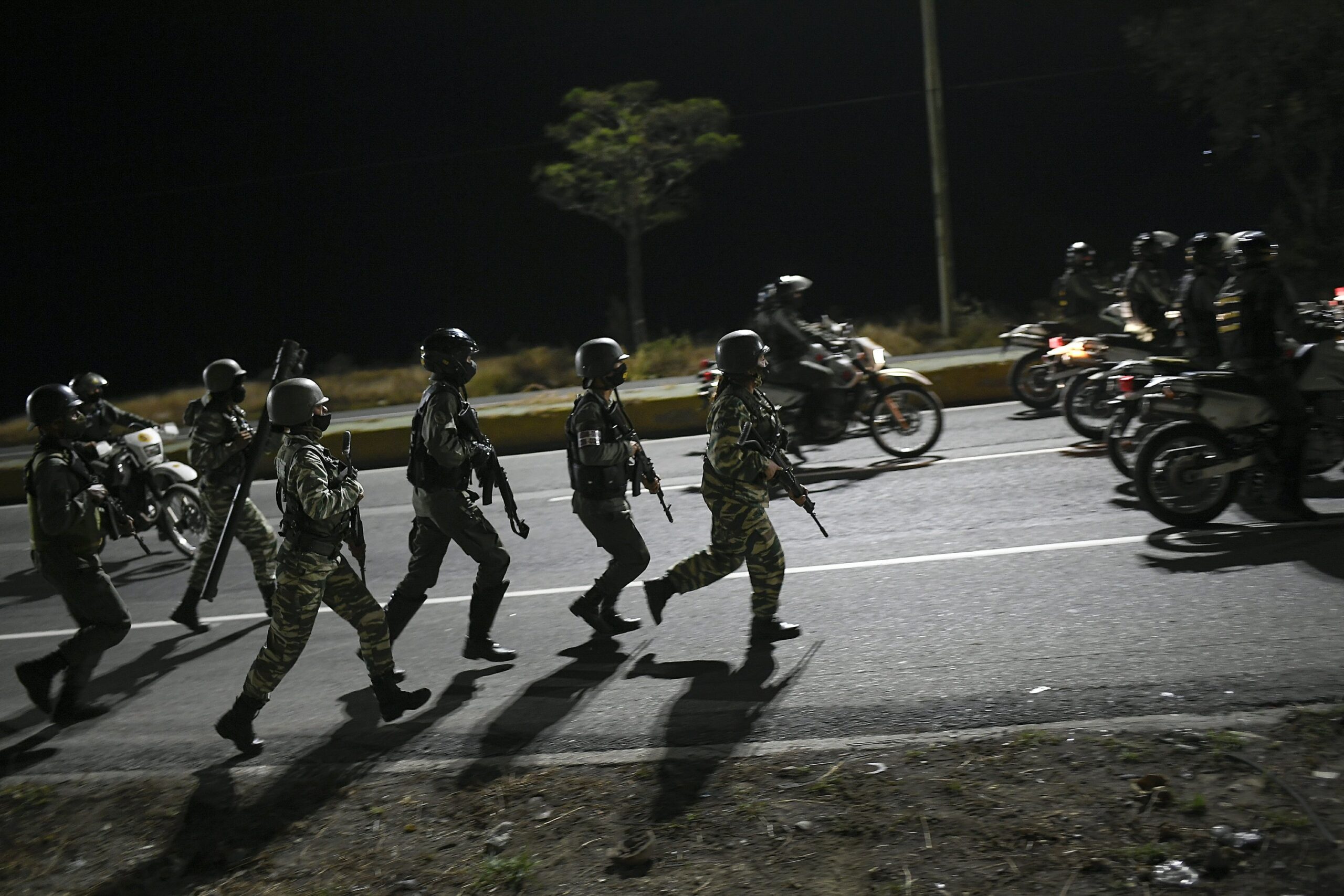Recent shootouts between Venezuelan security forces and the El Coqui gang included a clash in which at least two dozen people were gunned down, and experts warn of continued violence as the gang tries to advance on new territory.
In the last days of 2020, information began to circle that the El Coqui gang — which is one of Caracas’ largest criminal groups and is under the leadership of Carlos Luis Revete, alias “El Coqui,” — was seeking to expand north from its base in the Cota 905 neighborhood of Caracas to the nearby district of La Vega.
“From December 29, El Coqui’s people created a type of checkpoint overseen by young men…who are imposing a type of curfew,” one resident of Zulia street in La Vega told El Pitazo.
Security forces soon responded. On the afternoon of January 6, police forces engaged in a shootout with gang members in La Vega, according to a tweet by Venezuelan journalist Roman Camacho.
“People were too panicked to go out onto the street,” said one resident. Residents — who described the armed men as belonging to El Coqui’s gang — said they were warned that the gang would force out any police that entered La Vega. Camacho told InSight Crime that the gang managed to do just that, at least for a while.
However, the Venezuelan Special Action Forces (Fuerzas de Acciones Especiales – FAES) and other branches of Venezuelan police forces launched a full-scale invasion of La Vega in the early hours of January 8.
Two days later, reports emerged that the response, particularly from the FAES, had been overwhelmingly violent. Some two dozen residents had been killed by security forces during their operation, according to Runrun, which cited family members of alleged victims.
After the killings, clashes between authorities and El Coqui’s gang continued to escalate.
Since mid-January, police have attempted twice to take on the El Coqui gang on its home turf of Cota 905. On January 20, the Anti-Extortion and Kidnapping Command (Comando Antiextorsión y Secuestro – CONAS) exchanged shots with alleged kidnappers in the Los Laureles sector, which is on the outskirts of Cota 905.
Just over one week later, on January 28, Los Laureles was the scene of another confrontation between the El Coqui gang and security forces. According to El Pitazo, gang members ambushed police who had entered Los Laureles. The raid sparked a five-hour shootout that spilled over into the nearby neighborhood of El Paraíso. One alleged gang member was killed, while one bystander and one police officer were injured.
Violence in La Vega
After the violence in La Vega, news outlet Runrun identified several of the victims. Yerikson José García Duarte, a 32-year-old carpenter, was shot in the street while he was standing with friends. Raúl Antonio Lira Sánchez, a 25-year-old mechanic, was gunned down on his motorcycle with a friend. Jonathan Useche, 17, was seen being led away by FAES officers with a hood over his head. His body was later found in a morgue. Runrun also interviewed residents who said several people were killed inside their homes.
When seeking to verify these killings and those responsible, InSight Crime encountered differing versions of events. Family members of three separate victims, who spoke on the condition of anonymity because they fear for their lives, insisted that their loved ones had nothing to do with gangs. Marino Alvarado, the investigative coordinator of PROVEA, a Venezuelan human rights organization, supported these claims, telling InSight Crime that the group’s inquiries found neither police nor gang members among the dead.
But journalist Roman Camacho told InSight Crime that gang members were killed.
A resident, who spoke to InSight Crime by phone and asked not to be named because of security concerns, said some people in La Vega were thankful for the police intervening against El Coqui. Others were more afraid of the FAES. The FAES has a history of being connected to alleged extrajudicial executions in urban neighborhoods.
A relative of a shooting victim in La Vega, who spoke to InSight Crime through WhatsApp and asked for anonymity because she feared for her safety, said that her family member was shot after the FAES raided their home.
“It isn’t that I support the gang coming to the neighborhood, but you can’t destroy a child’s life because you want to kill someone,” she said.
Several questions are raised by the violence in La Vega and the following confrontations. Why did the El Coqui gang, which went years without seeking territorial expansion, target La Vega? Why did the FAES, even with its history of violence, respond with overwhelming force? And what does this mean for the expansion of Venezuela’s largest gangs, known as “megabandas,” which have risen to become one of the region’s principal criminal threats?
The answers lie partly with Revete, alias “El Coqui,” the long-term gang leader of the Cota 905 neighborhood. InSight Crime has previously reported on how Revete’s control of his gang and his territory has relied on a “peace zone” agreement with authorities since at least 2017, who largely leave him alone as long as he keeps the peace.
Under this tacit agreement, the megabanda has strengthened its control over criminal economies both inside and in the outskirts of Cota 905, buoyed by the informal restrictions on police’s entry into the neighborhood. El Coqui’s gang has sometimes drawn the attention of security forces, but authorities often stop short of pursuing gang members past the outskirts of Cota 905.
Alexander Campos, director of Venezuela’s Centro de Investigaciones Populares (Center for Social Investigations), suggested to InSight Crime this was why the El Coqui gang ambushed police in Los Laureles at the end of January. On the rare occasions that police have entered Cota 905, it has typically ended in violence, much like it did this time.
El Coqui has no such agreement providing him impunity in La Vega, leading to a predictably strong police response to his recent expansion attempt. And though it seems certain Revete saw an opportunity for expansion, he may have hedged his bets.
Both Camacho and Campos told InSight Crime that the armed men involved in the La Vega clashes were not directly members of Revete’s gang. Instead, it seems he may have used an alliance with another gang, led by alias “El Torta,” in his attempted takeover of La Vega. Camacho and Campos said their information pointed to El Torta’s men fighting the FAES.
This fits Revete’s usual strategy. His negotiation skills have not only helped him avoid government pursuit but also allowed him to build alliances with other gangs in different sectors of Cota 905 to consolidate his control.
The level of violence by authorities, however, was eye-catching. The police unit has often been deployed as a frontline force to cow rogue criminal elements. The United Nations Human Rights Council previously has singled the unit out for being involved in extrajudicial killings, but the unit’s tactics have not changed.
Expansion of Megabandas
The encroachment into La Vega represents Revete’s first known attempt at expansion, even if orchestrated through an allied proxy. There are likely several reasons that motivated him to expand, ranging from security to economic needs. While his control of Cota 905 is largely uncontested, he does not have much room to expand there. Meanwhile La Vega is a larger and more developed neighborhood, according to Luis Izquiel, a Venezuelan lawyer and long-time researcher of megabandas. As such, taking control of La Vega would provide the El Coqui gang with important new revenue streams through extortion and drug sales.
SEE ALSO: Enemies to Allies – How Venezuela Decides Which Criminal Groups Thrive
Campos agreed, noting that megabandas need to expand in order to provide enough income to their members. And the country’s economic crisis, exacerbated by the pandemic, may have accelerated this need, with several criminal economies providing significantly lower returns over the past year.
Camacho, who has reported extensively on the El Coqui megabanda, also pointed out that La Vega is more ideally situated as a home base from which the gang could carry out kidnappings in other sectors of Caracas. Although a halt in kidnappings was reported to be one of the conditions for El Coqui’s “peace zone” agreement with security forces, it did carry out several failed kidnapping attempts in 2020 that ended in shootouts.
This attempt by El Coqui to claim La Vega appears to have failed for now. But any future invasion may face severe pushback from security forces, with civilians caught in the crossfire.
The group is also putting its agreement inside Cota 905 in jeopardy. If the Maduro government sees Revete as acting in bad faith, especially as the situation between the gang and security forces continues to heat up, it may seek to remove him. He would not be the first gang leader to fall in and out of favor with the Maduro government in this manner.
Source: Insight Crime




